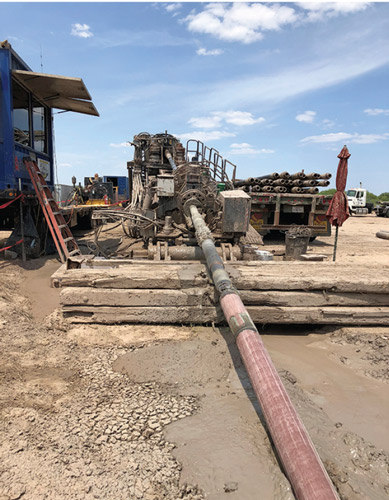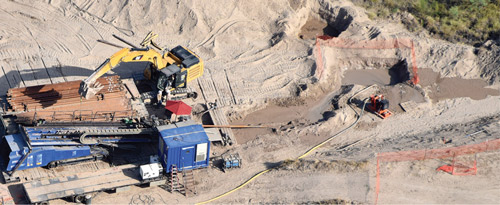May 2019, Vol. 246, No. 5
Features
Hard Rock Completes Rio Grande Directional Drill
By Jeff Griffin, Freelance Energy Writer
Every long horizontal directional drilling (HDD) installation has something that sets it apart from other projects, but not many involve crossing international boundaries.
An example of one that did is a recent river crossing completed by San Antonio contractor Hard Rock Directional Drilling. A 1,771-foot steel gas line was installed under the Rio Grande River as a section of a pipeline to carry natural gas from Mexico to a facility in the United States.
The pilot bore was launched on the U.S. side of the border with the exit point in Mexico.
Hard Rock contracted directly with the project owner for the HDD installation. Pipe handling, welding of the pipe string and support work was done by H&S Constructors.
“The river was full of beautiful water at this point, and we spent a lot of time planning to be sure there were no inadvertent fluid returns,” said Corey Baker, Hard Rock general manager. “We monitored mud properties to ensure we kept them at our pre-planned mud plan. We spend a lot of time before any crossing pre-planning all aspects of the crossing with mud being one of the most important elements of any crossing.”
An American Augers DD-440 with 440 pounds of thrust/pullback was used for the project. The drill was equipped with a mud motor and 10.15-inch TCI bit to drill the pilot hole. A Tensor tool was used for steering.
“We used a Hard Rock 14-inch hole opener,” Baker said. “We build most of the tooling in our fabrication ship.”
The pilot bore was launched from the U.S. side in Laredo, Texas, and drilled 510 feet before crossing the international border.
“After crossing the border, we drilled another 1,261 feet punching out in Mexico. We then had a crew go into Mexico, remove the motor and high-grade stainless Monel that houses the steering tool to help prevent some of the earth’s magnetic interference,” explained Baker.
Then the crew prepared for the pullback to the U.S. side. Surface conditions in the set-up area were shell and limestone. Average depth of the of the bore under the river was 65 feet.
Baker said the product to be installed was laid out and welded on the Mexican side and placed on rollers. The 14-inch cutter and swivel were connected to the product pipe string, and it was pulled back through the pilot hole. The pilot bore was completed in five days.
“The actual pullback only took a few hours,” Baker said, “but that was over two days due to crews crossing and re-crossing the border. During the project, our personnel never spent the night in Mexico, coming back to Texas after each day’s work was finished.”
From start to finish, this segment of the project was completed in 12 days.
What set this project apart from others, Baker said, obviously was crossing the boundary between the two countries. “It brought many challenges,” he continued.
Crossings for personnel were made at the World Trade Bridge a few miles from the bore’s crossing point.
“There were different taxes in each country, and ownership of equipment had to be presented. Every crew member who crossed the border had to have passports.
“Our biggest concerns for this project,” Baker said, “were getting equipment across and back to the States. We did a lot of research and planning to make this task move as successfully as it did.
“We also were concerned with inadvertent returns in the Rio Grande due to the fact it was not clear what Mexico’s regulations required. Therefore, we had to really concentrate on testing and keeping to our mud plan prepared by our third-party mud engineer Don White, of DCS Fluid Solutions. With all the research and consulting we did and the execution of our drill plan by our crew this was a huge success.
“This project was completed by our maxi rig division led by Tom Forconi and our 440-rig crew leader, Rafa Gamez, who as always did a flawless job.” P&GJ







Comments